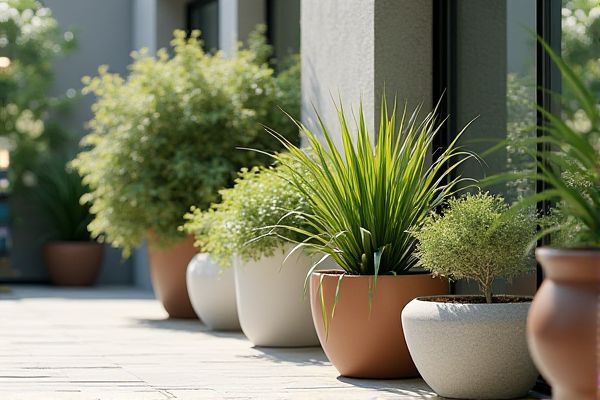
Plastic planters offer lightweight durability and affordability, making them ideal for easy handling and outdoor use, while ceramic planters provide superior aesthetic appeal and better insulation for plant roots but tend to be heavier and more fragile. Explore the rest of the article to discover which option best suits your gardening needs and enhances your green space.
Table of Comparison
| Feature | Plastic Planters | Ceramic Planters |
|---|---|---|
| Weight | Lightweight, easy to move | Heavy, less portable |
| Durability | Impact-resistant, less prone to breaking | Fragile, prone to cracking or chipping |
| Porosity | Non-porous, retains moisture | Porous, allows air and moisture flow |
| Drainage | Usually equipped with drainage holes | Often has drainage holes; some are waterproof |
| Temperature Sensitivity | Resistant to temperature variations | Can crack in extreme cold |
| Cost | Affordable, budget-friendly | Generally more expensive |
| Aesthetic Appeal | Simple designs, less variety | Elegant, decorative, various styles |
| Environmental Impact | Less eco-friendly, plastic waste concerns | More eco-friendly, biodegradable if unglazed |
Introduction to Plastic and Ceramic Planters
Plastic planters offer lightweight durability and affordability, making them ideal for easy relocation and budget-conscious gardeners. Ceramic planters provide a more porous surface that aids in moisture regulation, while their heavier weight offers stability for larger plants. Choosing between plastic and ceramic planters depends on your preferences for aesthetics, maintenance, and plant needs.
Material Composition and Durability
Plastic planters are made from lightweight, flexible polymers that resist cracking and damage from impacts, making them highly durable for outdoor use. Ceramic planters consist of fired clay, offering a sturdy but more brittle structure prone to chipping and breakage under harsh conditions. Your choice depends on whether you prioritize the shatter-resistance and portability of plastic or the aesthetic appeal and breathability of ceramic material.
Weight and Portability Comparison
Plastic planters are significantly lighter, often weighing less than half of ceramic planters of the same size, making them highly portable and easy to move for indoor or outdoor gardening. Ceramic planters, while heavier and more stable, can be cumbersome to relocate, especially when filled with soil and plants, limiting their flexibility for rearrangement. The lightweight nature of plastic planters also reduces the risk of damage to surfaces or injury during transport, favoring mobility over the robust durability of ceramic options.
Aesthetic Appeal and Design Options
Plastic planters offer a wide range of colors, shapes, and textures, providing versatility for various design aesthetics and modern outdoor or indoor settings. Ceramic planters, known for their glossy finishes and intricate patterns, bring a classic, upscale look that enhances garden or interior decor with a touch of elegance. While plastic excels in customization and lightweight convenience, ceramic stands out for its rich visual appeal and artisanal craftsmanship.
Suitability for Indoor and Outdoor Use
Plastic planters offer excellent versatility for both indoor and outdoor use due to their lightweight, durability, and resistance to moisture and weather conditions, making them ideal for patios, balconies, and indoor spaces. Ceramic planters, while aesthetically pleasing and providing better insulation for plant roots, are more fragile and suited primarily for indoor environments or sheltered outdoor areas where they are protected from extreme weather. Choosing between plastic and ceramic depends on balancing durability needs with design preferences and the specific environmental conditions of the planting location.
Drainage and Root Health
Plastic planters typically offer superior drainage options due to multiple drainage holes and lightweight design, reducing the risk of waterlogging and root rot. Ceramic planters, while aesthetically appealing, often retain moisture longer because of their thickness and fewer drainage holes, which can compromise root aeration and lead to fungal growth. Proper root health is maintained more effectively in plastic planters when adequate drainage is ensured, promoting stronger plant development.
Cost and Affordability
Plastic planters offer a budget-friendly option for gardening enthusiasts, often costing significantly less than ceramic planters while still providing durability and lightweight convenience. Ceramic planters, although pricier, bring a premium aesthetic and enhanced insulation for plant roots, justifying their higher cost. Your choice depends on balancing initial affordability with long-term style and maintenance needs.
Environmental Impact and Sustainability
Plastic planters contribute significantly to environmental pollution due to their non-biodegradable nature and reliance on fossil fuels, leading to long-term waste accumulation. Ceramic planters, made from natural clay, are more sustainable as they decompose over time and have lower carbon footprints during production. However, ceramic manufacturing can be energy-intensive, so choosing locally sourced, durable ceramic options enhances environmental benefits.
Maintenance and Cleaning Requirements
Plastic planters require minimal maintenance, as they are lightweight, durable, and resistant to cracking, making cleaning quick and easy with just soap and water. Ceramic planters often need more careful handling during cleaning to avoid chipping or cracking, and may require periodic sealing to prevent moisture damage and stains. Your choice depends on how much effort you want to invest in maintaining the planter's appearance and longevity.
Choosing the Right Planter for Your Plants
Plastic planters offer lightweight, affordable, and moisture-retentive benefits ideal for moisture-loving plants and easy mobility. Ceramic planters provide excellent durability, breathability, and aesthetic appeal, making them suitable for plants requiring better aeration and temperature regulation. Selecting the right planter depends on your plant's water needs, environmental conditions, and desired style.
 homyna.com
homyna.com